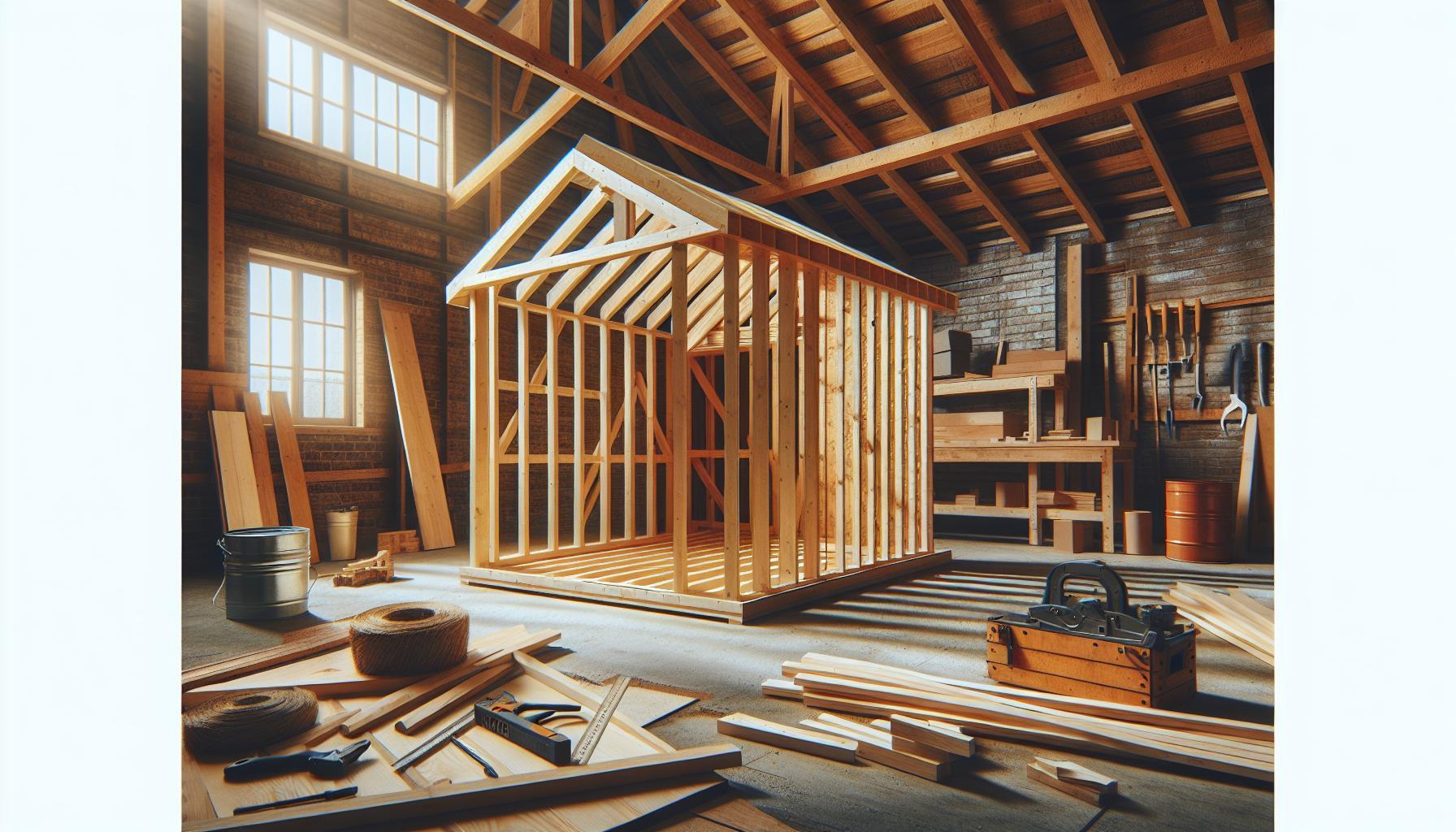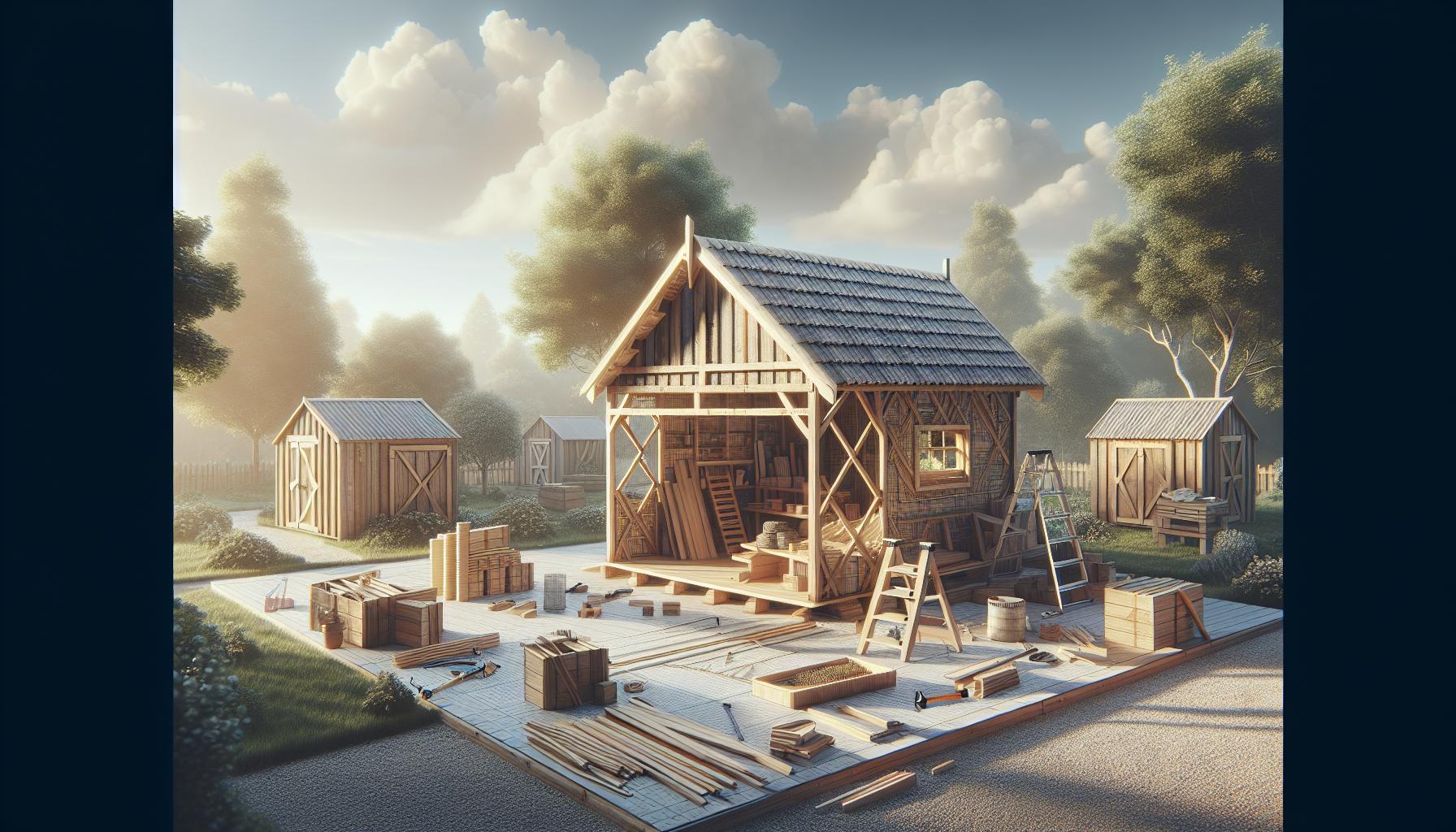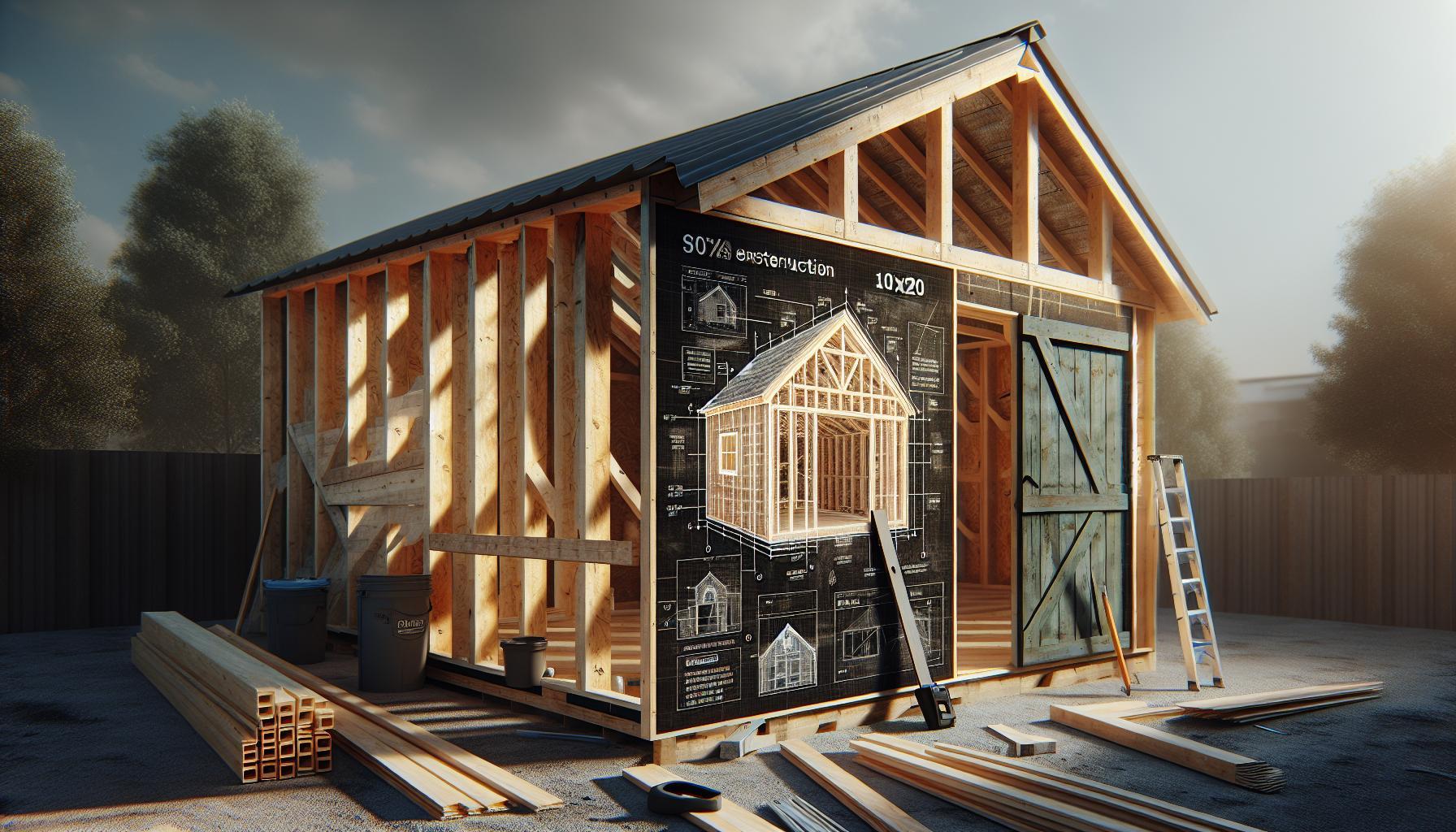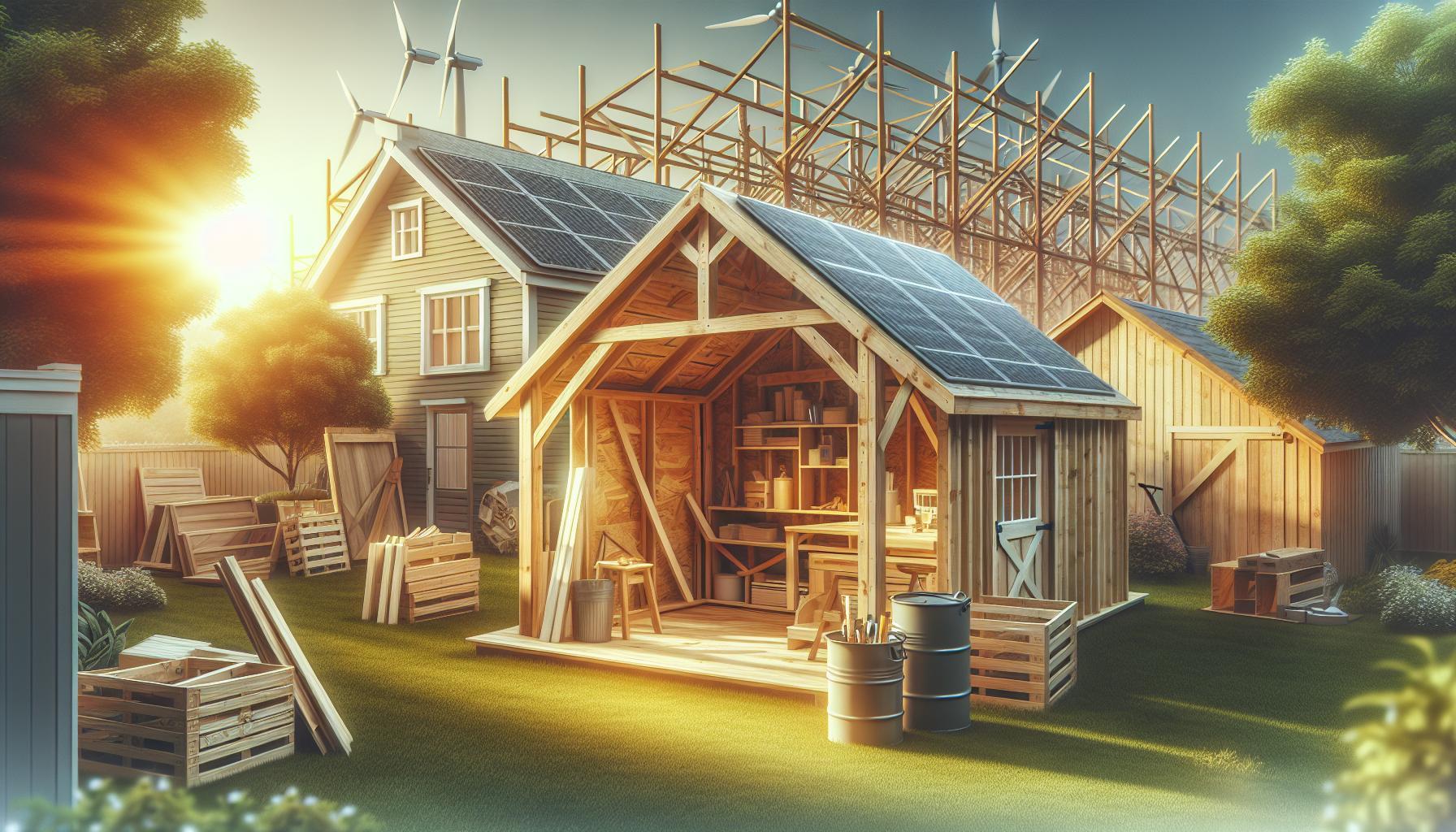Are you dreaming of building a perfect workshop but unsure about the costs? Understanding the budget for constructing a 10×20 shed is crucial for planning your ideal workspace. This breakdown will guide you through the expenses involved, ensuring you’re well-prepared to create a functional and stylish retreat for all your projects.
Understanding the Essential Costs: What Goes into a 10×20 Shed?
To transform your backyard into a functional dream workshop,understanding the costs associated with constructing a 10×20 shed is crucial. This space can serve as a tool storage area, a DIY workshop, or even a personal retreat. Though,the expenses involved in building a shed,especially on this scale,can add up quickly if not properly planned. Here’s a breakdown of the essential components that contribute to the overall cost, providing you clarity as you embark on this project.
Material Costs
The first major expense you’ll encounter comes from the materials needed to construct your 10×20 shed. Depending on the quality and type of materials you choose,this cost can vary significantly.
- Wood: A traditional wooden shed may require treated lumber for the frame and plywood for the walls. Expect to budget anywhere from $1,500 to $3,000 for high-quality wood.
- Roofing: Roofing materials, including shingles or metal sheets, can range from $500 to $1,500. Metal roofing tends to be more durable but comes at a higher price.
- Insulation: If you plan to use the shed year-round, consider adding insulation, which can run between $300 and $600, depending on the R-value and material.
Labor Costs
If you’re not planning to take on the construction yourself, hiring a contractor will significantly influence your budget. The labor costs for building a shed can fluctuate based on your location and the expertise of the contractor. Here’s a rough estimate:
| Type of Labor | Estimated Cost |
|---|---|
| General Contractor | $2,000 – $4,000 |
| Skilled Laborers (e.g., carpenters) | $25 – $50 per hour |
Consider seeking multiple quotes to ensure you’re getting a fair rate, and don’t hesitate to ask for references from past projects.
Additional Features and Permits
Other features can enhance both the utility and aesthetics of your shed but may also inflate your overall costs.
- Windows and Doors: Installing quality windows and doors can increase ventilation and enhance natural light, costing around $200 to $1,000 depending on the style.
- Electrical Setup: If you plan to power tools or install lighting, budgeting $500 to $1,200 for electrical work is advisable.
- Permits: Be sure to check local regulations regarding building permits,which might range from $100 to $500,depending on your municipality.
Understanding these essential costs behind building a 10×20 shed will equip you with the knowledge needed to make informed decisions as you budget for your dream workshop. By carefully evaluating each component,you can strike a balance between functionality,aesthetics,and your financial plan.
Selecting the Right Materials: Budget-Friendly Options Without Compromising Quality
when it comes to constructing a workshop, one of the most crucial decisions involves selecting materials. The choice of materials not only affects your budget but also determines the durability and longevity of your shed. fortunately, there are numerous budget-friendly options available that don’t compromise on quality, allowing you to create the workshop of your dreams without breaking the bank.
Consider option Materials
Sometimes, opting for less conventional materials can lead to significant savings. Here are a few economical choices to consider:
- Plywood: Rather of traditional lumber, consider high-quality plywood for the walls and flooring. It’s strong,resilient,and a cost-effective alternative.
- Metal Roofing: Instead of shingles, which may wear out over time, metal roofing panels provide excellent weather resistance and can last decades with minimal maintenance.
- Recycled Materials: Look for salvaged wood or reclaimed materials at local salvage yards. These can frequently enough be obtained at a fraction of the cost and add character to your workshop.
Prioritize Structural Integrity
When planning how much to build a 10×20 shed, it’s essential to ensure the structural integrity of your workshop. The initial installation costs may be higher but investing in materials that offer durability will save money in the long run. Here’s a comparison of structural materials:
| Material | Cost per Square Foot | Durability | Maintenance Required |
|---|---|---|---|
| pressure-Treated Lumber | $2.50 | High | Low |
| Plywood | $1.00 | Medium | Medium |
| Metal | $3.00 | Very High | Very Low |
Choosing the right materials means weighing the initial costs against long-term benefits. By selecting materials with a good balance of affordability and endurance, you can stay within your budget while ensuring that your workshop remains functional and lasts for years.
Utilize Efficient Building Techniques
In addition to selecting suitable materials, consider how your building techniques can further optimize costs.Simple design features, such as a gabled roof or standard-size doors and windows, can save on both materials and labor. Also, installing insulation can buffer energy costs when using electric tools or heating the space, creating a pleasant environment year-round.
By being strategic about material choices and building methods, you can turn your vision of a stunning workshop into a reality, all while effectively managing your budget.Remember, investing wisely now will pay off in the future, allowing your 10×20 shed to be a space for creativity and productivity without unneeded financial strain.
Planning Your Shed: Design Considerations That Affect Overall Costs
When it comes to building a shed, particularly a significant 10×20 workshop, the design phase is a critical aspect that can greatly influence your overall costs. Understanding the myriad design considerations will not only help you create a structure that meets your needs but also align your budget accordingly.From materials and layout to functional features, each decision carries financial implications that can transform your dream workshop into a reality or, conversely, a burden on your budget.
Materials Selection
Choosing the right materials is one of the foremost considerations when planning your shed.The quality and type of materials you select can significantly affect both the initial purchase and long-term maintenance costs. Such as, opting for pressure-treated lumber may incur a higher upfront cost but will offer greater durability against rot and pests. This investment coudl save you money in the long run. Here’s a brief comparison of common materials:
| Material Type | Initial Cost | Durability | Maintenance Needs |
|---|---|---|---|
| Wood | $3-$5 per sq.ft. | Moderate | Regular treatment needed |
| Vinyl | $5-$8 per sq. ft. | High | Minimal |
| Metal | $6-$10 per sq. ft. | Very high | Rust treatment required |
Considering your environment will further guide your choice. As an exmaple, regions prone to moisture might necessitate water-resistant materials, while areas with fluctuating temperatures may benefit from insulated panels, albeit at a higher cost.
Layout and Functional Design
The layout of your shed plays a crucial role in determining both functionality and cost. A well-thought-out design can maximize space and efficiency, while poor planning might lead to wasted materials and increased labor costs. Consider whether you will need extra features like windows, workbenches, or electrical outlets. Every additional element can escalate the overall price.
Think about creating designated zones for tools, storage, and workspace. This segmentation not only enhances usability but can also minimize the amount of materials needed for structural support.A simple floor plan could save you money, allowing for a more manageable initial buildup while ensuring room for future expansions.
Permits and Regulations
Lastly, don’t forget to factor in any necessary permits or local building regulations that may influence your design process.Each locality has different requirements that could add to your budget. Verify if your desired size, style, and placement comply with zoning laws, or if you need to invest in plans or consultations with professionals. These regulatory considerations can significantly impact your expenses and timeline,so it’s wise to account for them early in your planning stages.
By taking a comprehensive and thoughtful approach to design considerations before embarking on your shed project, you will not only create a workshop that suits your needs but also keep your expenses in check, ensuring your budget remains aligned with your vision for your dream workspace.
Labor Costs: DIY vs. Hiring Professionals for Your Shed Project
When considering the construction of a 10×20 shed, one of the most critical factors to weigh is the balance between labor costs associated with DIY efforts versus hiring professionals. It’s a decision that can significantly impact your overall budget and the quality of the finished project. Understanding the benefits and drawbacks of each option can definitely help you make the best choice for your situation and budget.
DIY: The Cost-Saving Option
Taking on a DIY shed project can be an attractive option, especially for those who relish the idea of building something with their own hands. One of the primary advantages is cost savings. By managing the construction yourself,you can avoid labor costs that typically account for a significant portion of the budget. here are a few points to consider:
- Materials Only: You only need to budget for materials,which can considerably decrease your overall expenses.
- Skill Development: Engaging in a DIY project fosters new skills, giving you hands-on experience in construction and carpentry.
- Customization: you have complete control over the design and can make adjustments as you go along.
However, DIY isn’t without its challenges. If you lack experience, you may encounter setbacks or mistakes that could lead to extra costs or a longer build time. This trade-off is essential to keep in mind when asking yourself, “How much to build a 10×20 shed?” as overestimating your abilities might just inflate your expenses later on.
hiring Professionals: The Assured Solution
On the other hand, hiring skilled professionals brings its own set of advantages and expenses. Although this route is generally more costly upfront, it can save you time and ensure a higher level of craftsmanship. Here’s what to think about:
- Expertise: Professionals bring valuable experience to your project, which can reduce the likelihood of errors and costly do-overs.
- Time Efficiency: With a team of experts, your shed can be completed much faster than if you were to tackle it alone.
- Warranties: Many contractors offer warranties on their work, providing peace of mind regarding potential future problems.
To weigh the pros and cons,you may consider the following table which breaks down potential costs:
| Option | Estimated Cost | Time Commitment | Skill Required |
|---|---|---|---|
| DIY | $1,500 – $3,000 | 4 weeks | Intermediate |
| Hiring Professionals | $3,000 – $6,000 | 1 – 2 weeks | None |
Ultimately,the decision between DIY and hiring professionals hinges on your budget,skill level,and how much time you can dedicate to the project. Reflecting on these factors while considering how much to build a 10×20 shed can lead you to a more informed decision, paving the way to your dream workshop.
Hidden Expenses: What to Expect Beyond the Initial Budget
Building a 10×20 shed can be an exciting project, but when diving into the budget, it’s crucial to consider those often-overlooked costs that can quickly add up.While you’ve likely mapped out your initial expenses like materials and labor, other hidden expenses may lurk in the shadows, potentially throwing your budget off balance. Understanding these additional costs can save you stress,ensuring that your dream workshop becomes a reality without financial surprises.
Common Hidden Costs to Anticipate
When planning your shed’s budget, it’s essential to keep in mind various potential expenses that might not be instantly apparent:
- Permits and Licenses: Before you start building, check with your local zoning regulations.Obtaining the necessary permits can cost additional fees that vary by location.
- Site Readiness: Clearing the land, leveling the ground, or adding a foundation can significantly impact your costs.Depending on the terrain and current site conditions, these expenses can fluctuate widely.
- Utilities Installation: If you plan to run electricity or plumbing, installation fees can accumulate quickly. Even basic setups require wiring,outlets,and possibly trenching costs.
- Interior Finishes: While you might have budgeted for the exterior, consider how you want to finish the interior. This includes insulation, paint, shelving, and flooring, all of which can inflate your total expenses.
- Inspections: Some areas require inspections throughout the building process, which can carry additional fees depending on how many stages you must pass.
Sample Budget Breakdown
To provide a clearer picture, here’s an illustrative budget breakdown for building a 10×20 shed, integrating both expected and hidden costs:
| Expense Type | Estimated Cost |
|---|---|
| Materials (lumber, roofing, etc.) | $2,000 |
| Labor | $1,500 |
| Permits | $200 |
| Site Preparation | $300 |
| Utilities setup | $500 |
| Interior Finishes | $800 |
| Inspections | $150 |
| Total Estimated Cost | $5,600 |
This breakdown serves as a reminder that when assessing how much it costs to build a 10×20 shed, the total budget should encompass both apparent and less obvious expenses. Preparing for these hidden costs will ultimately lead to a smoother construction process and ensure you’re enjoying your new workshop to its fullest.
Permits and Regulations: Understanding the Legal Aspects of Shed Construction
when it comes to constructing a shed, especially one that functions as a workshop, understanding the legal landscape is crucial. Many enthusiasts often underestimate the importance of permits and regulations, which can ultimately dictate everything from the shed’s design to its location. Ignoring these aspects can lead to fines, forced removal, or additional costs that could have easily been avoided.
Why Permits Matter
Before diving into the exciting process of building your dream workshop, it’s essential to grasp why acquiring the necessary permits is non-negotiable. building codes and zoning laws vary widely from one area to another, typically enforced by local municipalities or homeowners’ associations. These regulations ensure that the structures built within a community meet safety standards and are aesthetically aligned with the surrounding properties.
Consider these aspects when researching local regulations:
- Building Codes: Each area has specific codes dictating the safety standards for construction materials and techniques.
- Zoning Laws: These laws determine how land can be used and often specify where structures can be placed on your property.
- Setback Requirements: Most areas have specific distance regulations from the property line, which can directly impact where the shed can be situated.
- Fees and Inspections: be prepared to pay request fees and undergo a series of inspections to ensure compliance with the regulations.
Steps to Ensure Compliance
Navigating the complexities of permits and regulations doesn’t have to be overwhelming. here’s a step-by-step guide to keep you on track:
- Consult Local Authorities: Start by contacting your local building department or municipal office to get a clear understanding of the requirements.
- Prepare Necessary Documentation: Once you have the guidelines, gather documentation such as property surveys, shed plans, and any other required paperwork.
- Submit Your Permit Application: Complete the required forms and pay any associated fees to initiate the review process.
- schedule Inspections: After obtaining your permit, don’t forget to schedule any required inspections during different phases of construction.
By taking these steps before breaking ground, you can focus on the fun parts of your project without the looming threat of legal complications after the fact. Building a 10×20 shed might be an exciting endeavor in the journey to your ideal workshop, but it’s vital to ensure you’re adhering to the legal standards of your locality.
Case Studies: Real-Life Budget Breakdowns from Actual Shed Builds
Building a shed can be a fulfilling project, especially when tailored to suit your specific needs and preferences. As you embark on this journey, understanding real-life budget breakdowns from actual shed builds can provide invaluable insights and aid in your planning. Here, we share detailed case studies to demonstrate how others achieved their dream workshops, focusing on a 10×20 shed’s costs, materials, and personal experiences.
Case Study 1: DIY Enthusiast in the Suburbs
One homeowner decided to construct a 10×20 shed as a workshop for his woodworking hobby. With a budget of approximately $3,500, he outlined his expenditures in a clear manner:
| Item | Cost |
|---|---|
| Shed Kit (pre-cut wood) | $1,200 |
| Roofing Material | $500 |
| Insulation | $300 |
| Electrical Wiring & Fixtures | $600 |
| Flooring | $400 |
| Tools & Supplies | $500 |
After completing the build, he shared that the most significant challenge was coordinating materials. To maximize budget and efficiency,he opted to source some materials locally,which saved on shipping costs. This project not only resulted in a functional workshop but also fostered a sense of accomplishment and creativity.
Case Study 2: Family Outdoor retreat
Another family focused on creating a shed that would serve as both a storage space and a recreational retreat. They allocated $4,000 for the entire project, prioritizing durability and aesthetics.
| Item | Cost |
|---|---|
| Foundation (concrete slabs) | $800 |
| Wood (framing and siding) | $1,200 |
| Windows and Doors | $900 |
| Paint & Finishing | $500 |
| Landscaping around the shed | $600 |
This family emphasized the importance of not just the shed’s functionality but also integrating it into their garden design.They noted that while they faced a few weather delays, careful planning and communal effort made the construction process much smoother.
Key Lessons Learned
From these case studies, several critically important takeaways emerge for anyone considering how much to build a 10×20 shed.Whether you’re looking at budget considerations or logistical challenges, these insights can inform your own project and enhance your decision-making process:
- Set a Clear Budget: Establish a budget that accounts for all aspects of the build, including unexpected costs.
- Plan for Weather Delays: Be mindful of local climate conditions that can impact construction timelines.
- Involve Family or Friends: Not only can this expedite the process, but it strengthens relationships through shared experiences.
Real-life examples from shed builds reveal common challenges while also showcasing the rewards of construction. By learning from others’ experiences, you can better navigate your own path toward building the shed of your dreams.
FAQ
How Much to Build a 10×20 Shed? Budget Breakdown for Dream Workshops?
Building a 10×20 shed can cost between $2,500 to $7,000 depending on materials, permits, and labor. A detailed budget breakdown considers both basic and quality features, making it essential for your dream workshop.
it’s critically important to factor in materials such as wood, roofing, and siding when budgeting. Permits can vary by location, and if you hire contractors, labor costs can significantly increase your total.To get the most value, consider doing some tasks yourself, like assembling or painting.
What materials do I need to build a 10×20 shed?
To build a 10×20 shed, you’ll typically need wood (for framing and walls), roofing materials, siding, insulation, and flooring. Additional tools and supplies include nails, screws, and paint.
Consider using high-quality materials for durability, especially in parts exposed to weather. For a DIY project, a detailed materials list will help you stay organized and on budget. You can find comprehensive lists and plans in our related article on shed construction basics.
Can I build a 10×20 shed myself?
Yes, you can definitely build a 10×20 shed yourself, but it requires careful planning and some basic carpentry skills. Many DIYers successfully complete this project with the right resources and techniques.
Start by gathering woodworking tools and checking local building codes to ensure compliance. Follow a step-by-step guide, and don’t hesitate to ask for help if you encounter challenges. With patience and determination, you can create a workshop tailored to your needs!
Why does the cost vary for building a 10×20 shed?
The cost for building a 10×20 shed varies due to factors such as materials, labor, and regional building codes. The choice of design and finishes also impacts the overall price.
For example, opting for treated lumber versus untreated can save costs, but affects durability. Additionally, requesting quotes from local contractors can reveal significant differences in labor costs. Research and compare options to find the best fit for your budget.
What is the best foundation for a 10×20 shed?
The best foundation for a 10×20 shed is a level concrete slab or treated wooden skids. Both options provide stability and longevity, preventing issues like moisture damage.
Concrete slabs are more permanent but require more work, while wooden skids are easier to install and move if necessary. Always ensure the foundation is level and meets local guidelines, which can impact your shed’s durability and functionality.
How long does it take to build a 10×20 shed?
Building a 10×20 shed typically takes 1-2 weekends for someone with moderate experience. this timeframe can vary based on preparation, weather, and design complexity.
Preparation,including gathering materials and tools,can take additional time. If you’re planning to do this as a weekend project, enlisting a freind can help speed up the process and make it more enjoyable.
What permits do I need to build a 10×20 shed?
Permits for building a 10×20 shed vary by location but may include a building permit and zoning clearance. Check with your local municipality for specific requirements.
In some areas, permits may not be necessary for structures under a certain size. However, it’s wise to verify local ordinances to avoid fines or demolition. Researching regulations early in your project ensures a smooth building experience.
Concluding Remarks
building a 10×20 shed is an exciting journey that combines creativity, practicality, and budget management. As we’ve explored, breaking down the costs—from materials and permits to tools and labor—can definitely help you gain a clear understanding of what to expect financially. Remember, every project comes with its own unique challenges, but with careful planning and resourcefulness, you can overcome them with confidence.
Whether you’re a seasoned DIYer or just starting your workshop dreams, this guide has armed you with the essential knowledge to tackle your shed construction head-on. Don’t hesitate to explore local resources, connect with fellow builders, and ask questions along the way. The more informed and prepared you are, the smoother your project will go.
So, roll up your sleeves, pour that enthusiasm into your work, and let your dream workshop come to life! Keep the spirit of craftsmanship alive and remember, the only limit is your imagination. Happy building!









